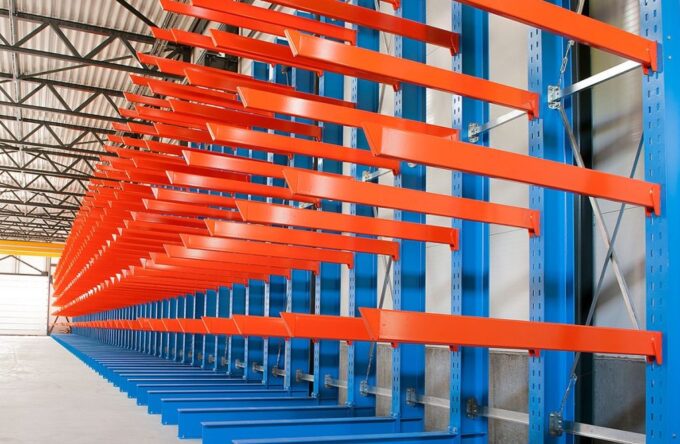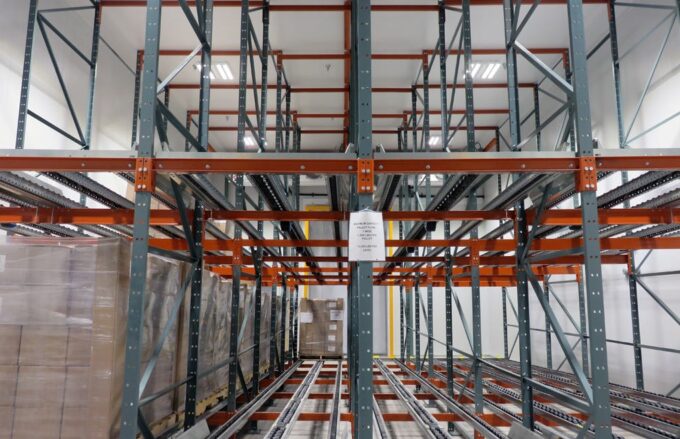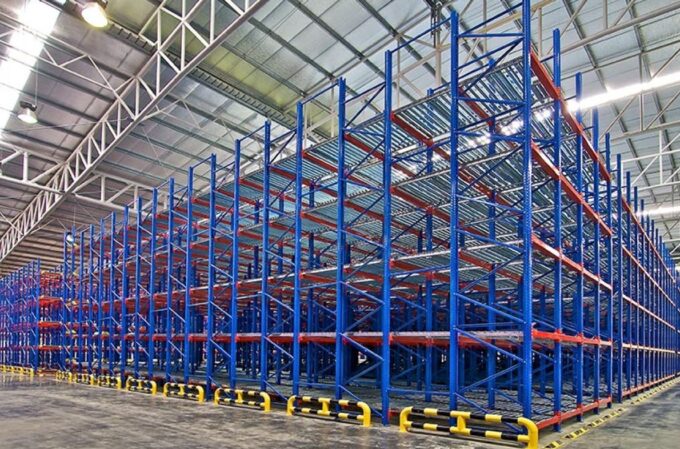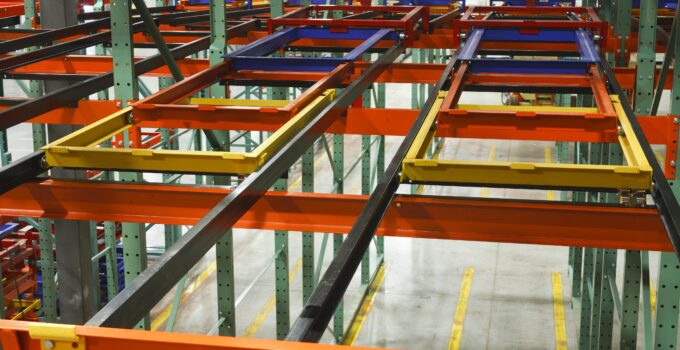Unlike standard racking, where each pallet stands alone, push back racking cleverly stacks them. This high-density storage frees up more floor space for your warehouse needs. Plus, the inclined rails automatically shift pallets toward the front as you unload, keeping everything readily accessible.
Push back racking pallets tightly onto inclined rails, utilizing space better than traditional systems. New pallets push older ones deeper, creating a last-in, first-out flow. This push back racking system saves space by using fewer aisles and allowing easy access to every pallet.
Push back racking isn’t just efficient; it’s also versatile. It handles various pallet sizes and weights, making it adaptable to diverse industries and applications. Just remember – proper training is key to ensuring safe pallet handling in this dynamic system.
With its space-saving design, easy access, and versatility, push back racking proves itself a top choice for businesses seeking to optimize their warehouse storage.
How Does Push Back Racking Work? A Step-by-Step Explanation

Source: youtube.com
Push back racking is a popular storage system that maximizes warehouse space utilization and provides efficient inventory management. This system works on the principle of “last in, first out” (LIFO), where products are loaded from the front and pushed back as new items are added. Here is a step-by-step explanation of how push back racking works:
- Installation: Push back racking consists of a series of inclined rails or lanes that are mounted on a sturdy frame structure. These lanes are typically made of steel and have rollers or wheels to facilitate smooth movement.
- Loading: To begin, products are loaded onto carts or pallets at the front of each lane. The carts or pallets are then placed on the inclined rails, which allow gravity to aid in the movement of the products.
- Pushing: As more products are added to the lane, they push the previously loaded items towards the back of the rack. This is achieved by gently pushing each cart or pallet with a new one, causing them to roll along the inclined rails towards the rear.
- Storing: The push back racking system allows for multiple levels of storage, with each lane accommodating several carts or pallets. As new items are added, they are stored behind the previously loaded ones, creating a compact and efficient storage layout.
- Retrieval: When it comes time to retrieve a product, warehouse operators can access it from the front of the rack easily. As they remove an item, the remaining ones roll forward due to gravity, ensuring that the next product in line is readily available for picking.
- Continuous replenishment: Push back racking is designed for continuous replenishment, ensuring a constant flow of products from the front to the back. This makes it ideal for storing goods with high turnover rates or expiration dates since it facilitates proper stock rotation.
- Flexibility: Push back racking systems can be customized to suit various storage requirements. The number of lanes, depth of storage, and overall configuration can be adjusted based on the specific needs of the warehouse and the products being stored.
Push back racking is a dynamic storage solution that maximizes space utilization and facilitates efficient inventory management.
By utilizing gravity and a last-in, first-out approach, this system enables easy loading, pushing, storing, and retrieval of goods. Its flexibility and ability to accommodate high turnover rates make push back racking a popular choice for many warehouses.
The Advantages of Using Push Back Racking in Warehouses and Distribution Centers

Source: linkedin.com
Push back racking is a popular storage solution used in warehouses and distribution centers, offering several advantages over traditional racking systems. Here are some key benefits of using push back racking:
- Increased storage capacity: Push back racking maximizes storage space by allowing for high-density storage. The system utilizes a series of inclined rails and nested carts that slide along them, enabling multiple pallets to be stored on each level. This results in a higher storage capacity compared to other racking systems.
- Improved accessibility and selectivity: Unlike drive-in or drive-through racking systems, push back racking provides better accessibility and selectivity. Each lane operates independently, allowing for easy access to individual pallets without the need to move others. This feature makes it suitable for warehouses with a high variety of SKUs or products with varying turnover rates.
- FIFO inventory management: Push back racking follows the first-in, first-out (FIFO) inventory management principle. As new pallets are loaded onto the system, they push older pallets towards the opposite end of the lane. This ensures proper stock rotation, reducing the risk of product spoilage or obsolescence.
- Time and labor-saving: Push back racking simplifies loading and unloading processes, saving time and labor. The inclined design allows for gravity-assisted movement, making it easier for forklift operators to slide pallets into position or retrieve them. With less manual effort required during handling, productivity can be significantly increased.
- Increased safety: The design of push back racking incorporates safety features that help prevent accidents and damage to both workers and goods. The inclined rails keep the pallets securely in place, reducing the risk of product shifting or falling during handling. Additionally, the system’s interlocking carts provide stability and prevent accidental dislodgement.
- Versatility and adaptability: Push back racking can be customized to meet specific storage requirements. The number of levels, lane lengths, and load capacities can be tailored to accommodate different pallet sizes, weights, and storage needs. This flexibility allows for efficient utilization of available warehouse space.
Push back racking offers numerous advantages for warehouses and distribution centers. It maximizes storage capacity, improves accessibility and selectivity, follows FIFO inventory management, saves time and labor, enhances safety, and provides versatility in storage configurations. Implementing push back racking can lead to improved operational efficiency and optimized use of warehouse space.
Common Applications and Industries that Benefit from Push Back Racking Systems

Source: facebook.com
Push back racking systems are versatile storage solutions that offer several benefits for a wide range of applications and industries. Here are some common applications and industries that can benefit from push back racking systems:
- Warehousing and Distribution: Push back racking systems are widely used in warehouses and distribution centers to maximize storage capacity and improve efficiency. They allow for high-density storage while maintaining accessibility to individual pallets.
- Food and Beverage: The food and beverage industry often deals with perishable goods that require proper rotation to ensure freshness. Push back racking systems facilitate FIFO (First-In, First-Out) inventory management, making them ideal for storing items with expiration dates.
- Manufacturing: Manufacturing facilities can optimize their storage space by using push back racking systems to store raw materials, components, and finished products. These systems provide easy access to materials, reducing the time needed for picking and replenishment.
- Retail: Retail stores can utilize push back racking systems to efficiently store a large volume of products in a compact space. This helps maximize the sales floor area while ensuring quick and easy restocking.
- Automotive: The automotive industry often deals with heavy and bulky items such as tires, parts, and accessories. Push back racking systems can handle the weight and size of these items effectively, providing convenient access during order fulfillment or assembly processes.
- E-commerce: With the rapid growth of e-commerce, efficient storage and order fulfillment processes are crucial. Push back racking systems enable better organization and faster picking, making them suitable for e-commerce warehouses that handle a large number of SKUs.
- Cold Storage: Push back racking systems are also commonly used in cold storage facilities, such as refrigerated warehouses or freezers. They can withstand low temperatures while offering dense storage capacity for perishable items.
- 3PL (Third-Party Logistics): Third-party logistics providers can benefit from push back racking systems as they handle diverse inventory for multiple clients. The system’s flexibility allows for efficient storage management and easy segregation of goods.
Push back racking systems have widespread applications across various industries, including warehousing, food and beverage, manufacturing, retail, automotive, e-commerce, cold storage, and 3PL. These systems offer improved storage capacity, accessibility, and organization, contributing to enhanced operational efficiency and productivity.
Comparing Push Back Racking with Other Storage Solutions: Is it the Right Choice for You?
When considering storage solutions, it is important to assess the specific needs and requirements of your business. Push back racking is a type of high-density storage system that offers several benefits compared to other storage solutions.
One of the key advantages of push back racking is its ability to maximize warehouse space utilization. This system allows for multiple pallets to be stored on a single lane, with each pallet being pushed back as new pallets are loaded. This means that more inventory can be stored in the same amount of space, making it an efficient option for businesses with limited storage capacity.
Another benefit of push back racking is its ease of use. With this system, pallets can be loaded and unloaded from the same aisle, reducing the need for additional access points and improving overall efficiency. Additionally, the inclined rails on which the pallets slide ensure smooth movement and prevent damage to both the pallets and the racking system.
Furthermore, push back racking offers a first-in-last-out (FILO) inventory rotation system. This means that the last pallet loaded onto a lane will be the first one to be unloaded, which can be advantageous for businesses dealing with perishable or time-sensitive products.
However, it is important to consider some factors before deciding if push back racking is the right choice for your business. This storage solution requires a forklift with specialized attachments to operate effectively, so you must ensure that your equipment is compatible. Additionally, while push back racking offers high-density storage, it may not be suitable for all types of products or industries.
In conclusion, push back racking can be an excellent choice for businesses looking to maximize warehouse space utilization and improve efficiency. However, it is crucial to evaluate your specific requirements and consider factors such as compatibility with existing equipment and product suitability before making a final decision.
Predictions for the Future of Push Back Racking: Trends to Watch Out For in 2024 and Beyond

Source: pinterest.com
As an AI language model, I can provide you with some insights and predictions for the future of push back racking. While it’s challenging to predict specific trends for 2024 and beyond, based on current industry developments, here are a few areas to watch out for:
- Automation and Robotics: The adoption of automation and robotics is likely to increase in push back racking systems. Automated guided vehicles (AGVs) may be integrated into the racking system, enabling efficient movement of pallets within the warehouse. This can lead to improved productivity and reduced labor costs.
- Advanced Tracking and Monitoring: With the advancements in Internet of Things (IoT) technology, push back racking systems may incorporate sensors and real-time monitoring capabilities. These sensors can provide valuable data on inventory levels, weight distribution, and structural integrity, helping optimize storage space utilization and prevent accidents.
- Sustainability and Eco-friendly Designs: In response to growing environmental concerns, push back racking systems may see a shift towards more sustainable materials and designs. Companies might prioritize using recycled materials or exploring alternative energy sources to power automated systems.
- Integration with Warehouse Management Systems (WMS): Push back racking systems are likely to become more seamlessly integrated with WMS software. This integration can enable improved inventory management, order fulfillment, and optimization of storage space based on demand patterns.
- Customization and Flexibility: As supply chains become more dynamic, push back racking systems may need to adapt to frequent changes in product sizes or packaging configurations. Manufacturers may focus on developing modular designs that allow for easy reconfiguration or customization to accommodate evolving storage needs.
- Enhanced Safety Features: Safety will continue to be a priority in warehouse operations. Push back racking systems may feature improved safety mechanisms such as collision detection sensors, better load stability mechanisms, and enhanced training programs to minimize the risk of accidents.
It’s important to note that these predictions are based on current industry trends and technological advancements. The future may bring unexpected developments that could further shape the evolution of push back racking systems.
Embracing the Efficiency and Versatility of Push Back Racking for Optimal Warehouse Storage Solutions in 2024

Source: dreamstime.com
Traditional warehouse storage is space-hungry and inflexible. Push back racking rewrites the rules. This dynamic system maximizes space by stacking pallets deep on inclined rails, using a “last in, first out” flow. Empty aisle days are over!
But push back racking is more than just a space saver. Its adaptable design fits various pallet sizes and weights, adjusting to your specific needs. Whether you’re dealing with seasonal fluctuations or ever-changing inventory, this system flexes with you.
And it’s not just about storing more in less space. Push back racking speeds up access compared to older alternatives. Plus, it boasts built-in safety features like brakes and stops, keeping your warehouse operations safe and efficient.
Push back racking is a game-changer for warehouses in 2024 and beyond. It’s the ultimate space-saving hero, a versatile champion for adaptable storage, and a safety champion all rolled into one. Embrace the future of warehousing, embrace push back racking.







